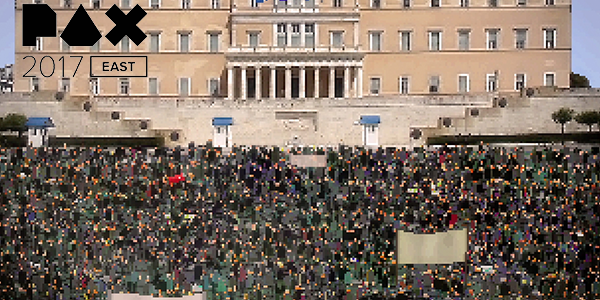It’s difficult to know exactly how to feel after playing RIOT: Civil Unrest. As consummate resistance song “Gimme Shelter” echoed through a darkened building where protesters occupied, Merry Clayton’s iconic refrain are quickly drowned out by the sounds of batons and ballistics. On your order, riot police are clearing the building by whatever brutal means necessary. As the screen fades to black you win, but at what cost?
That sort of uneasiness is a deliberate component of this game, and it feels like every corner of the design is geared towards delivering dissonance. The sounds, from the music selection to the wails of protesters and the shouts of police, capture the tense feeling of danger and unpredictability of citizen protests as the tiptoe on the edge of physical conflict.
[youtube id=”https://youtu.be/Flhlo8_qasI” width=”600″ height=”350″]
Each stage is modeled and inspired by actual protests around the world and throughout history, like the Tahir Revolution in Egypt or the Italian NoTav Movement. This is part of what made the game difficult for me to play, at first. I’m participating in the gamification of real life events with real human costs. I’m letting loose armed security to dismantle free assembly as savagely as they see fit for a score. That tension and conflict I was feeling in front of a keyboard was nothing compared to what developer and former Valve cinematographer Leonard Menchiari experienced when he actually participated in some big demonstrations across the world.
“Other than watching tons of videos, I experienced crowd behaviors in person several times in different locations and observed what happened.” he told ZAM earlier this year in an interview. From first hand experiences in protests like the Spanish Indignados movement, he created a system of behaviors and trends that made the crowd act and feel like a group of people reacting with various levels of cohesion against the presence of “The Man.” He’s synthesized the real fear, strength, and hope of the people into 1’s and 0’s and sound and art to give players like me cause to react in a real way to this sort of violence. Real, compared to the military shooters and open world stab simulators that linger in a realm of dehumanization close to the top of the sales charts. I was feeling awkward, but at least I was feeling something.
I was also uncomfortable playing due to the fact that I had no great understanding of what my actions were doing. When playing as police, things seem pretty simple. You walk forward and look foreboding, pushing people back until they won’t be moved. When they begin pushing back, you pull out sticks. When they start throwing things and lighting fires, you pull out smoke and guns. If they riot, you riot.
As civilians, your options are a bit more obtuse. You can raise your hands and sit down, but I don’t know how that tangibly affects the armored mass in front of you, besides “makes it gradually harder for them to move you.” You can escalate to firecrackers in the street and firebombs, but they both seemed like express trips to beatdown town. One option allowed me to call more protesters, as the ones present began to get hauled away into police vans. You could also turn the mob angry, and let them rush the cops to send their message with fists. I could only barely establish what the right course of action was in certain scenarios. I think that’s where more gamification is required – of all the feelings this game was giving me, I wasn’t getting a plethora of useful information in regards to completing the tasks at hand.
Hopefully, when RIOT: Civil Unrest launches sometime this year, this vision will amalgamate into the cohesive and provocative game that my time spent at Merge Games’ booth has convinced me it can be.







